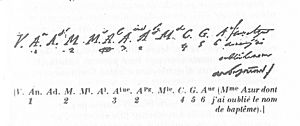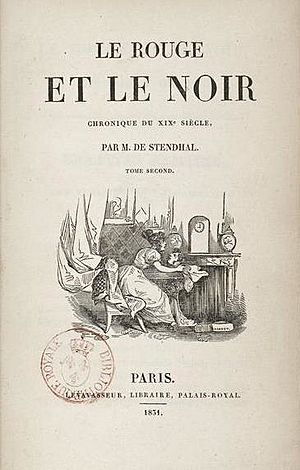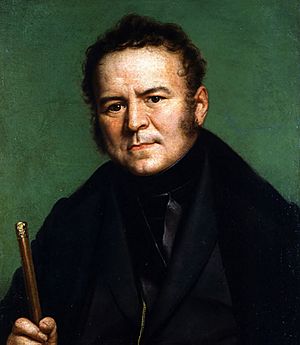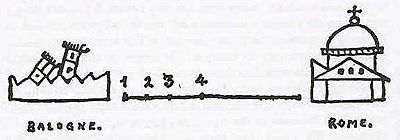Stendhal facts for kids
Quick facts for kids
Marie-Henri Beyle
|
|
|---|---|
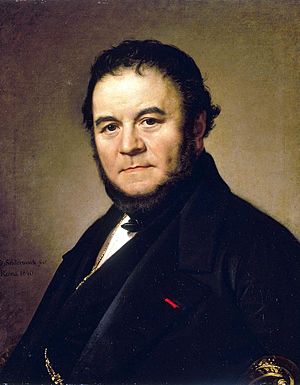
Stendhal, painted by Olof Johan Södermark in 1840
|
|
| Born | 23 January 1783 Grenoble, Dauphiné, Kingdom of France |
| Died | 23 March 1842 (aged 59) Paris, July Monarchy |
| Resting place | Cimetière de Montmartre |
| Occupation | Writer |
| Literary movement | Realism |
Marie-Henri Beyle (born January 23, 1783 – died March 23, 1842) was a French writer from the 1800s. He is much better known by his pen name Stendhal.
He is most famous for his novels Le Rouge et le Noir (which means The Red and the Black, published in 1830) and La Chartreuse de Parme (The Charterhouse of Parma, published in 1839). People admire his writing because he was very good at understanding and showing the inner thoughts and feelings of his characters. He is seen as one of the first and most important writers of realism, a style that tries to show life as it truly is. Stendhal called himself an "egotist," and he gave this same trait to his characters, calling it "Beylism."
Contents
Stendhal's Life Story
Marie-Henri Beyle was born in Grenoble, France. He had a difficult childhood. He didn't get along with his father and was very sad when his mother, whom he loved deeply, died when he was only seven years old. He spent some of his happiest years at his family's country house near Grenoble. His younger sister, Pauline, was his closest friend, and they wrote many letters to each other.
Stendhal was very interested in the military and theater during the time of the First French Empire (when Napoleon ruled France). He joined the French government and took part in the Napoleonic Wars in Italy. He traveled a lot in Germany and was part of Napoleon's army when they invaded Russia in 1812.
He saw Moscow burning from outside the city and experienced the army's difficult winter retreat. He was put in charge of getting supplies for the returning army in Smolensk. He managed to cross the Berezina River safely, which likely saved his life. He returned to Paris in 1813. During the Russian campaign, Stendhal was known for staying calm and clear-headed, even shaving every day during the retreat from Moscow!
After Napoleon's defeat in 1814, Stendhal moved to Italy and settled in Milan. He loved Italy and spent much of his life there. In 1830, he became a French consul (a government official who represents his country) in Trieste and Civitavecchia. His novel The Charterhouse of Parma, which he wrote in just 52 days, is set in Italy. He thought Italy was a more honest and passionate country than France at that time.
Stendhal believed in liberalism, which is a political idea about freedom and equal rights. His time in Italy made him think that Romanticism in literature was like liberalism in politics. When he was appointed consul in Trieste in 1830, a powerful Austrian statesman named Metternich refused to let him take the job because of Stendhal's liberal and anti-religious views.
Stendhal was known in Paris as a fashionable and witty person. He also had many romantic interests. He showed great understanding and sympathy for women in his books. Simone de Beauvoir, a famous writer, praised him for seeing women as complete human beings, not just as they relate to men. She even called him a feminist writer because of his strong female characters.
One of his early books, On Love, explores romantic feelings in a thoughtful way. It was based on his own unrequited love (love that is not returned) for Mathilde, Countess Dembowska. He also felt sad when a childhood friend, Victorine, got married, describing her as the woman of his dreams. This mix of clear thinking and strong emotions is a key part of Stendhal's great novels. He is often called a "Romantic realist."
In his last years, Stendhal suffered from health problems, but he still wrote some of his most famous works. He died on March 23, 1842, after collapsing on the streets of Paris. He is buried in the Cimetière de Montmartre in Paris.
Why Stendhal Used Other Names
Before he decided to use "Stendhal" as his main pen name, he published books under many other names, like "Louis Alexandre Bombet." The only book he published using his real name, Marie-Henri Beyle, was The History of Painting (1817).
From 1817 onwards, he started publishing his works as "M. de Stendhal, officier de cavalerie" (a cavalry officer). He chose the name "Stendhal" from a German city called Stendal. This city was the birthplace of Johann Joachim Winckelmann, a famous art historian at the time.
In 1807, Stendhal had stayed near Stendal and fell in love with a woman named Wilhelmine, whom he called Minette. He stayed in the city because of her. He even added an extra "H" to "Stendal" to make the name sound more German.
Stendhal used more than a hundred different fake names in his personal writings and letters. He even gave fake names to his friends, and some of them started using those names themselves! He used names like "Dominique" and "Salviati" for close friends, and sometimes funny names like "William Crocodile" or "Baron de Cutendre." One of his friends said he never wrote a letter without signing a fake name.
In his diary, Stendhal wrote about enjoying the idea of "feeling alive in many versions." He once wrote, "Look upon life as a masked ball." He even dreamed of changing into a tall, blonde German and walking around Paris like that!
Stendhal's Books and Writings
Readers during Stendhal's time (the Romantic period) didn't fully understand or appreciate his realistic writing style. He only became truly famous and admired at the beginning of the 20th century. He often said he wrote for "the Happy Few," meaning a small group of people who would truly understand his work. This phrase might come from a book called The Vicar of Wakefield by Oliver Goldsmith. In that book, "the happy few" jokingly refers to the small number of people who read a very specific and academic book.
As a literary critic, Stendhal supported the Romantic style of writing. In his work Racine and Shakespeare, he compared the strict rules of Jean Racine's classical plays unfavorably to the freer style of William Shakespeare. He believed plays should be written in prose (like everyday speech), not just poetry.
Stendhal's novel The Red and the Black is considered his tribute to Napoleon, whom he admired. In this novel, Stendhal described a novel as being like "a mirror being carried in a basket." This means that a realistic novel reflects the world around it, but the writer chooses what to show, just like a mirror doesn't show everything. The goal is to help readers understand life better.
Today, Stendhal's works are popular because of their irony (saying one thing but meaning the opposite) and their deep psychological and historical insights. Stendhal loved music, especially the works of composers like Wolfgang Amadeus Mozart and Gioachino Rossini. He even wrote a biography of Rossini, Vie de Rossini (1824), which is valued more for its musical opinions than for its historical facts.
Novels by Stendhal
- Armance (1827)
- Le Rouge et le Noir (The Red and the Black, 1830)
- Lucien Leuwen (1835, unfinished, published 1894)
- The Pink and the Green (1837, unfinished)
- La Chartreuse de Parme (1839) (The Charterhouse of Parma)
- Lamiel (1839–1842, unfinished, published 1889)
Short Novels (Novellas)
- Mina de Vanghel (1830)
- Vanina Vanini (1829)
- Italian Chroniques, 1837–1839, which includes:
- Vittoria Accoramboni
- The Cenci (Les Cenci, 1837)
- The Duchess of Palliano (La Duchesse de Palliano)
- The Abbess of Castro (L'Abbesse de Castro, 1832)
Biographies by Stendhal
- A Life of Napoleon (1817–1818, published 1929)
- A Life of Rossini (1824)
Autobiographical Works (About His Own Life)
- The Life of Henry Brulard (1835–1836, published 1890)
- Souvenirs d'Égotisme (written in 1832 and published in 1892) (Memoirs of an Egotist)
- Journal (1801–1817) (The Private Diaries of Stendhal)
Other Non-Fiction Works
- Rome, Naples et Florence (1817)
- De L'Amour (1822) (On Love [fr])
- Racine et Shakespéare (1823–1835) (Racine and Shakespeare)
Stendhal also wrote short stories, newspaper articles, travel books, and essays about Italian painting.
What is Crystallization in Love?
In his 1822 book On Love [fr], Stendhal described how love begins. He called this process "crystallization." He compared it to a trip to Rome.
Imagine you are in the city of Bologna. You feel nothing special for someone you might later fall in love with. Your imagination isn't making them seem more wonderful than they are. This is like the start of the journey, where "crystallization" hasn't begun.
Then, the journey starts. You leave Bologna, climb the Apennines mountains, and head towards Rome. This journey represents how love develops. It's not something you choose; it just happens. Stendhal said this process has four steps:
- Admiration – You start to notice and appreciate the good qualities of the person you like.
- Acknowledgement – You realize it's nice that they seem interested in you too.
- Hope – You start to imagine that you could win their love.
- Delight – You feel happy and start to think the person is even more beautiful and wonderful than they really are, because you hope to win their love.
Stendhal first explained this "crystallization" idea on the back of a playing card while talking to a friend during a trip to a salt mine.
What Critics Thought of Stendhal
Many important writers and thinkers have praised Stendhal's work.
Hippolyte Taine, a French historian, said that Stendhal's characters felt "real" because they were complex and unique, just like real people. Émile Zola, another famous writer, agreed that Stendhal was excellent at understanding human minds.
The German philosopher Friedrich Nietzsche called Stendhal "France's last great psychologist." He even said that discovering Stendhal was one of the most important moments in his life.
Ford Madox Ford, an English novelist, believed that Stendhal helped the novel become a serious way to explore human life and important ideas.
Erich Auerbach, a literary critic, thought that modern "serious realism" in novels began with Stendhal. He noted that Stendhal's stories are deeply connected to the political, social, and economic conditions of the time they were written. This means to truly understand his novels, you need to know about the history of that period.
Simone de Beauvoir used Stendhal as an example of a feminist writer. She wrote that Stendhal "never describes his heroines as a function of his heroes: he provides them with their own destinies." This means he gave his female characters their own important lives and goals, not just roles related to men. She also pointed out that Stendhal was both a romantic and a feminist, calling for women's freedom not just for general equality, but for their individual happiness.
Even Stendhal's own autobiographical books, like The Life of Henry Brulard, are closely tied to the politics and society of his time. It shows that major historical events affected him deeply.
Michael Dirda, a modern critic, considers Stendhal "the greatest all round French writer." He praises Stendhal for writing two of the best French novels, a very original autobiography, and excellent travel books.
Stendhal Syndrome
In 1817, Stendhal visited Florence, Italy, and was reportedly overwhelmed by all the beautiful art and culture he saw there. He felt a strong emotional and physical reaction.
This feeling was later named "Stendhal syndrome" in 1979 by an Italian psychiatrist named Dr. Graziella Magherini. She noticed that many first-time visitors to Florence experienced similar physical feelings, like a racing heart, nausea, and dizziness, when surrounded by so much beauty.
As a tribute to Stendhal, the Italian train company Trenitalia named their overnight train service from Paris to Venice the "Stendhal Express." Don't worry, this train ride doesn't cause any physical distress!
See also
 In Spanish: Stendhal para niños
In Spanish: Stendhal para niños



